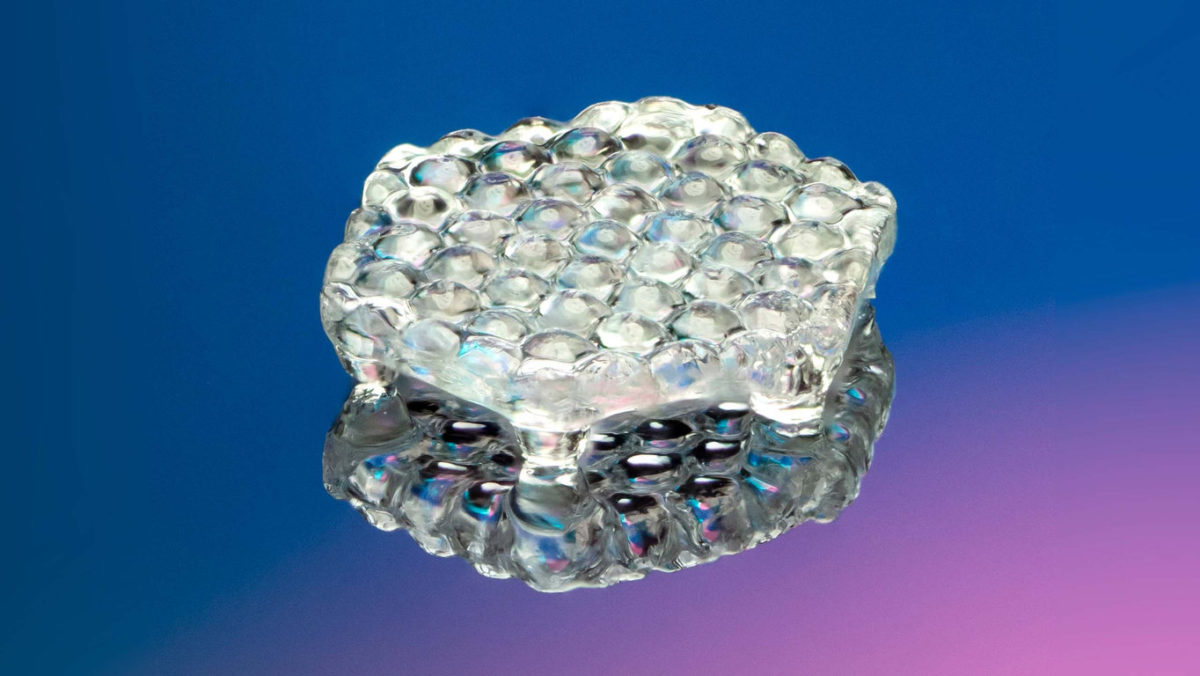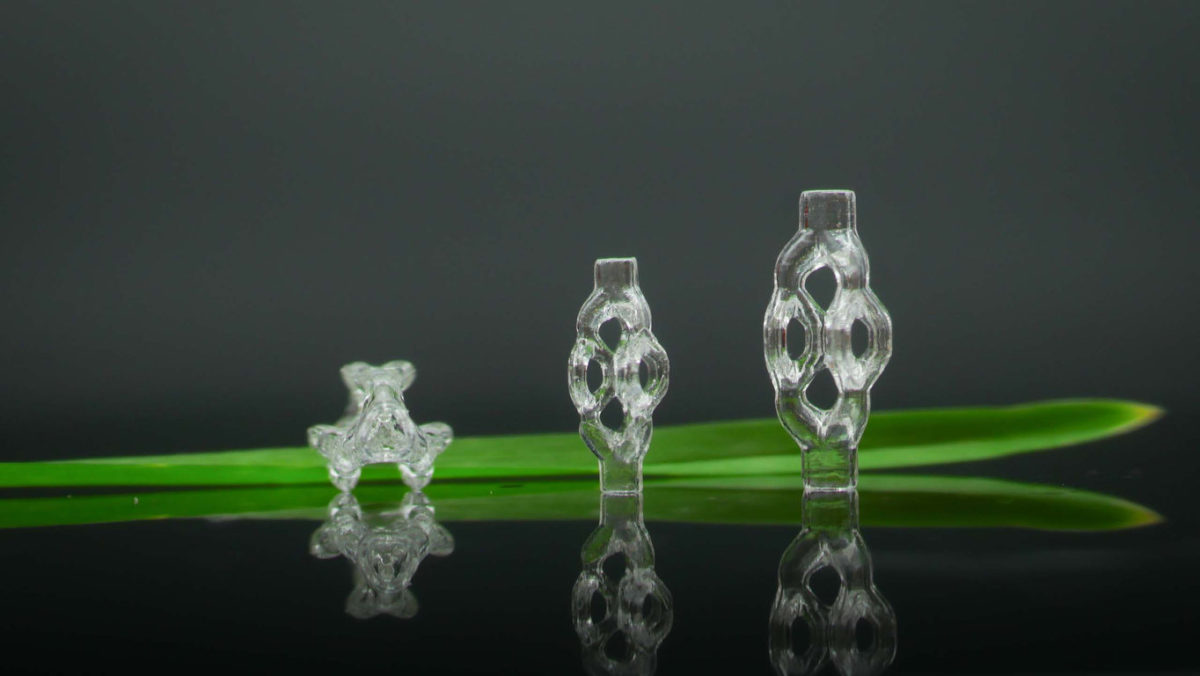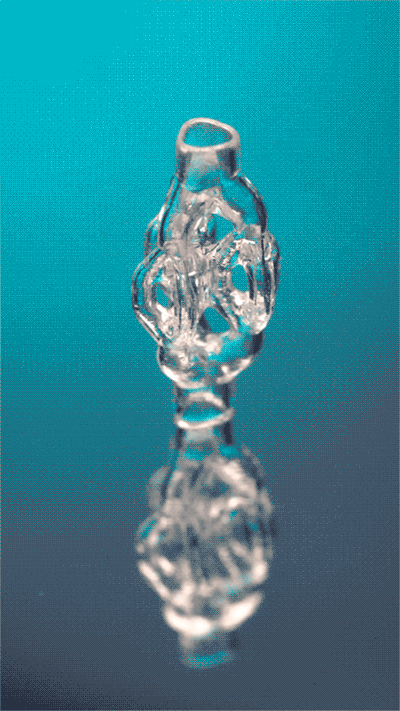创新背景
玻璃是制造复杂微观物体的首选材料,包括智能手机和内窥镜中使用的紧凑型高质量相机中的镜头,以及用于分析或处理微量液体的微流体设备。但目前的制造方法可能缓慢、昂贵,并且满足行业不断增长的需求的能力有限。
创新过程
研究人员与德国弗莱堡阿尔伯特路德维希大学的科学家合作,扩展了他们开发过的3D打印工艺——计算机轴向光刻(CAL),以打印更精细的特征并在玻璃中打印。他们称这个新系统为“micro-CAL”。
CAL工艺与当今的工业3D打印制造工艺有着根本的不同,后者从薄层材料中构建物体。这种技术可能非常耗时,并导致表面纹理粗糙。然而,CAL同时3D打印整个物体。研究人员使用激光将光图案投射到旋转体积的光敏材料中,建立3D光剂量,然后固化成所需的形状。CAL工艺的无层特性可实现光滑的表面和复杂的几何形状。

3D打印的六边形微透镜阵列
这项研究突破了CAL的界限,以证明其能够在玻璃结构中打印微尺度特征。当这个方法在2019年首次被发表时,CAL可以将物体打印成具有小至约三分之一毫米的聚合物,而通过micro-CAL,可以在聚合物中打印物体,其特征低至约20百万分之一米,或大约是人类头发宽度的四分之一。研究人员首次展示了这种方法不仅可以打印到聚合物中,还可以打印到玻璃中,其特征低至约50百万分之一米。

3D打印的三叉微管模型
为了打印玻璃,研究团队与弗莱堡阿尔伯特路德维希大学的科学家合作,他们开发了一种特殊的树脂材料,其中包含被光敏粘合剂液体包围的玻璃纳米颗粒。来自打印机的数字光投射使粘合剂固化,然后研究人员加热打印的物体以去除粘合剂并将颗粒融合在一起形成纯玻璃的固体物体。

这里的关键推动因素是粘合剂的折射率与玻璃的折射率几乎相同,因此光线通过材料几乎没有散射,CAL打印工艺和这种新开发的材料有很高的匹配度。
研究小组进行测试时,发现CAL打印的玻璃物体比使用传统的基于层的打印工艺制成的物体具有更一致的强度。当玻璃物体包含更多缺陷或裂缝或表面粗糙时,它们往往更容易破裂。因此,CAL能够使物体具有比其他基于图层的3D打印工艺更光滑的表面,这是一个巨大的潜在优势。
创新关键点
研究人员开发了一种特殊的树脂材料,其中包含被光敏粘合剂液体包围的玻璃纳米颗粒。来自打印机的数字光投射使粘合剂固化,然后研究人员加热打印的物体以去除粘合剂并将颗粒融合在一起形成纯玻璃的固体物体。
创新价值
CAL 3D打印方法为微观玻璃制品制造商提供了一种新的、更有效的方法,以满足客户对几何形状、尺寸以及光学和机械性能的苛刻要求。具体而言,这包括微观光学元件的制造商,这些元件是紧凑型相机、虚拟现实耳机、先进显微镜和其他科学仪器的关键部分。
The innovative development of a new system "micro-CAL" can print microscale features in glass structures
Working with scientists at Albert Ludwig University in Freiburg, Germany, the researchers extended a 3D printing process they had developed, called Computerized Axial lithography (CAL), to print finer features and print them in glass. They call the new system "micro-CAL."
The CAL process is fundamentally different from today's industrial 3D printing manufacturing processes, which build objects from thin layers of material. This technique can be very time consuming and result in rough surface textures. However, CAL 3D prints the entire object at the same time. The researchers used lasers to project light patterns onto a rotating volume of light-sensitive material to establish a 3D dose of light, which was then solidified into the desired shape. The layer-free nature of the CAL process enables smooth surfaces and complex geometric shapes.
This research pushes the boundaries of CAL to demonstrate its ability to print microscale features in glass structures. When the method was first published in 2019, CAL could print objects into polymers as small as about a third of a millimeter. With micro-CAL, it was possible to print objects in polymers with features as low as about two millionths of a meter, or about a quarter of the width of a human hair. The researchers have shown for the first time that the method can be printed not only into polymers but also into glass, with characteristics as low as about five millionths of a meter.
To print the glass, the research team worked with scientists at Albert Ludwig University in Freiburg, who developed a special resin material containing glass nanoparticles surrounded by a light-sensitive adhesive liquid. Digital light projection from the printer solidifies the adhesive, and the researchers then heat the printed object to remove the adhesive and fuse the particles together to form a solid object of pure glass.
The key driving factor here is that the refractive index of the adhesive is almost identical to that of the glass, so there is little scattering of light through the material, and the CAL printing process and this newly developed material have a good match.
When the team ran tests, they found that the glass objects printed by CAL had more consistent strength than those made using a traditional layer-based printing process. When glass objects contain more defects or cracks or have a rough surface, they tend to break more easily. So CAL's ability to make objects have smoother surfaces than other layer-based 3D printing processes is a huge potential advantage.
智能推荐
新材料 | 不可逆聚合物提高二维聚合物性能,推动材料学发展
2022-06-29利用单体分子特性组成不可逆聚合物,提高二维聚合物的稳定性。
涉及学科涉及领域研究方向使用硫化学气相沉积制备超高折射率的聚合物
2022-08-05通过一步法气相沉积工艺提高折射聚合物薄膜的高透明度。
涉及学科涉及领域研究方向新材料 | 创新利用”catholyte”开发新材料可使植入式电池更持久
2022-11-07研究人员提出了一种新方法来提高这些不可充电电池的能量密度,种技术可以使使用寿命增加50%。
涉及学科涉及领域研究方向新材料 | 创新开发专用材料可更精确地控制光的偏振
2022-10-13研究人员使用一种只有三个原子厚的专用材料,可以比以往更精确地控制光。
涉及学科涉及领域研究方向